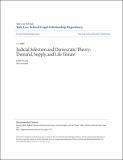|
Reseña:
|
How ought a democracy select its judges? Critics in Canada, England, andWales invoke the democratic values of accountability and transparency to call for adiminution in prime ministerial control over judicial appointments. In the UnitedStates, Article III of the Constitution's text directs that the President nominatewiththe advice and consent of the Senate-life-tenured federal judges. Bitterconflicts about particular nominees have produced many proposals for changes ofthat system. And in those states that rely on various forms of judicial election,concerns focus on funding and campaigning. In short, both globally and locally,democracies debate the legitimacy and wisdom of various methods used to endowindividuals with the state's power of adjudication.This diversity of techniques for judicial selection illuminates the complexrelationship of adjudication to democracies. Democracy tells one a good dealabout rights to justice, equality before and in the law, and constraints on the powerof the state, its courts included. But absent a claim that all government officials ina democracy must be elected, it is difficult to derive from democracy any particularprocess for picking judges. In contrast, democratic principles do rule out a fewprocedures for judicial selection-such as by inheritance or through techniquesthat systematically exclude persons by race, sex, ethnicity, and class.In addition to examining the interaction between democratic theory andHow ought a democracy select its judges? Critics in Canada, England, and Wales invoke the democratic values of accountability and transparency to call for a diminution in prime ministerial control over judicial appointments. In the UnitedStates, Article III of the Constitution's text directs that the President nominate with the advice and consent of the Senate-life-tenured federal judges. Bitter conflicts about particular nominees have produced many proposals for changes of that system. And in those states that rely on various forms of judicial election, concerns focus on funding and campaigning. In short, both globally and locally, democracies debate the legitimacy and wisdom of various methods used to endow individuals with the state's power of adjudication. This diversity of techniques for judicial selection illuminates the complex relationship of adjudication to democracies. Democracy tells one a good deal about rights to justice, equality before and in the law, and constraints on the power of the state, its courts included. But absent a claim that all government officials in a democracy must be elected, it is difficult to derive from democracy any particular process for picking judges. In contrast, democratic principles do rule out a few procedures for judicial selection-such as by inheritance or through techniques that systematically exclude persons by race, sex, ethnicity, and class.In addition to examining the interaction between democratic theory and udicial selection, this article details the degree to which the life-tenured (or Article III) judiciary in the United States has become anomalous, both when compared to high court judgeships in other countries and to other kinds of federal judges-magistrate and bankruptcy judges-in this country. Article III judges have no mandatory age for retirement nor a fixed, non-renewable term of office. Rather, they serve relatively long terms-often of more than twenty years. In addition, they control the timing of their resignations, enabling them to bestow political benefits on a particular party. Further, Article III judges now have the authority to appoint hundreds of non-life-tenured federal judges. |

